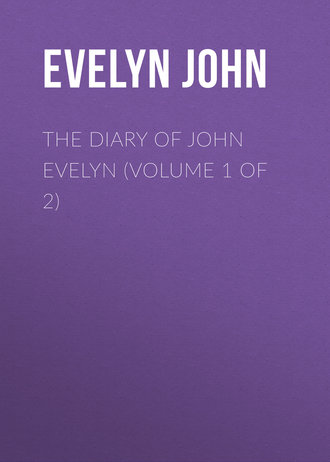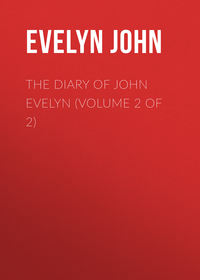 полная версия
полная версияThe Diary of John Evelyn (Volume 1 of 2)
25
This very book, by one of those curious chances that occasionally happen, found its way into England some forty years ago, and was seen by the Editor of the early edition of this "Diary." It may be worth remarking that wherever, in the course of it, the title of "Defender of the Faith" was subjoined to the name of Henry, the Pope had drawn his pen through the title. The name of the King occurred in his own handwriting both at the beginning and end; and on the binding were the Royal Arms. Its possessor had purchased it in Italy for a few shillings from an old bookstall.
26
Such is the inscription, as copied by Evelyn; but as its sense is not very clear, and the Diary contains instances of incorrectness in transcribing, it may be desirable to subjoin the distich said (by Keysler in his "Travels," ii. 433) to be the only one in the whole mausoleum:
"Quæ cineris tumulo hæc vestigia? conditur olimIlle hoc qui cecinit pascua, rura, duces."27
Evelyn's dates in this portion of his Diary appear to require occasionally that qualification of "about."
28
And in the cup an UNION shall he throw,Richer than that which four successive kingsIn Denmark's crown have worn.Shakespeare, "Hamlet," Act v. Sc. 2.Theobald says, an UNION is the finest sort of pearl, and has its place in all crowns and coronets. The Latin word for a single large pearl, it is hardly necessary to add, is unio.
29
Cardinal Hippolito Aldobrandini was elected Pope in January, 1592, by the name of Clement VIII., and died in March, 1605.
30
A guillotine.
31
What particular Richard King of England this was, it is impossible to say; the tomb still exists, and has long been a crux to antiquaries and travelers.
32
They were taken away by Bonaparte to Paris; but in 1815, were sent back to Venice.
33
St. Peter's disciple, first Bishop of Padua.
34
The celebrated Thomas, Earl of Arundel, part of whose collection was eventually procured for the University of Oxford by Evelyn, and is distinguished by the name Marmora Arundeliana.
35
Or della Scala.
36
Bonaparte afterward took it, and placed it on his own head.
37
Sir Arthur Hopton was uncle, not brother, to Lord Hopton (so well known for his services to Charles in the course of the Civil War).
38
The lady here referred to was Lucy, daughter of Richard Walters, Esq., of Haverfordwest. She had two children by the King; James, subsequently so celebrated as the Duke of Monmouth, and Mary, whose lot was obscure in comparison with that of her brother, but of course infinitely happier. She married a Mr. William Sarsfield, of Ireland, and after his death, William Fanshawe, Esq.
39
This he does not fail to repeat at the end of every year, but it will not always be necessary here to insert it.
40
A copy of it is subjoined. "These are to will and require you to permit and suffer the bearer thereof, John Evelyn, Esq., to transport himself, two servants, and other necessaries, into any port of France without any your lets or molestations, of which you are not to fail, and for which this shall be your sufficient warrant. Given at the Council of State at Whitehall this 25th of June, 1650.
"Signed in the Name and by Order of the Council of State,appointed by authority of Parliament,Jo. Bradshawe, President."To all Customers, Comptrollers and Searchers, and all other officers of the Ports, or Customs."
Subjoined to the signature, Evelyn has added in his own writing; "The hand of that villain who sentenced our Charles I. of B[lessed] M[emory."] Its endorsement, also in his writing, is, "The Pass from the Council of State, 1650."
41
The famous Venetian writer on Temperance.
42
A native of Essex, who was born in 1582, educated abroad, and, his family being Catholic, became a priest of that church, the sub-rector of the college at Douay. He advocated the Cartesian philosophy, and this brought him into an extensive correspondence with Hobbes and Descartes, in the course of which he Latinized his name into Thomas Albius, or De Albis. He died in 1676.
43
Sister of Colonel Lane, an English officer in the army of Charles II. dispersed at the battle of Worcester. She assisted the King in effecting his escape after that battle, his Majesty traveling with her disguised as her serving man, William Jackson.
44
The Duke of Orleans, taken at the battle of Agincourt, 4 Hen. V., by Richard Waller, then owner of this place. See Hasted's "Kent," vol. i., p. 431.
45
The book here referred to is in the British Museum, entitled "Joannis Barclaii Icon Animarum," and printed at London, 1614, small 12mo. It is written in Latin, and dedicated to Louis XIII. of France, for what reason does not appear, the author speaking of himself as a subject of this country. It mentions the necessity of forming the minds of youth, as a skillful gardener forms his trees; the different dispositions of men, in different nations; English, Scotch, and Irish, etc. Chapter second contains a florid description of the beautiful scenery about Greenwich, but does not mention Dr. Mason, or his house.
46
Evelyn is here in error: Mr. Hyldiard was of East Horsley, Sir Walter of West.
47
See under the year 1688, November.
48
Such were the speaking figures long ago exhibited in Spring Gardens, and in Leicester Fields.
49
King Stephen was buried at Faversham. The effigy Evelyn alluded to is that of Robert Curthose, Duke of Normandy.
50
Marble, inlaid of various colors, representing flowers, birds, etc.
51
A conduit it should rather be called.
52
The reader must remember that an Oxford man is speaking.
53
The text was 2 Cor. xiii 9. That, however persecution dealt with the Ministers of God's Word, they were still to pray for the flock, and wish their perfection, as it was the flock to pray for and assist their pastors, by the example of St. Paul. – Evelyn's Note.
54
Many years ago, Lord Dundonald revived the project, with the proposed improvement of extracting and saving the tar. Unfortunately he did not profit by it. The coal thus charred is sold as COKE, a very useful fuel for many purposes.
55
Evelyn means the younger Vane. This was "Vane, young in years, but in sage counsel old," the nobleness and independence of whose character, as well as his claims to the affection of posterity, are not ill expressed in the two facts recorded by Evelyn – his imprisonment by Cromwell, and his judicial murder by Charles II. The foolish book to which Evelyn refers was an able and fearless attack on Cromwell's government.
56
This was probably the animal called a Mocock (maucaco), since well known.
57
Beckmann, in his "History of Inventions," has written an account of the different instruments applied to carriages to measure the distance they pass over. He places the first introduction of the adometer in England at about the end of the seventeenth century, instead of about the middle, and states it to have been the invention of an ingenious artist named Butterfield.
58
Not far from the course of the Roman Road from Chichester, through Sussex, passing through Ockley, and Dorking churchyard. Considerable remains of a Roman building have since been found on Waltonheath, south of this house.
59
Afterward one of Charles II.'s mistresses.
60
William, afterward third Lord Brereton; an accomplished and able man, who assisted Evelyn in establishing the Royal Society. He died in 1679.
61
With the title of "The Late News, or Message from Brussels Unmasked." This, and the pamphlet which gave rise to it, are reprinted in "Evelyn's Miscellaneous Writings."
62
Pieces of money, so called from the figure of an angel on them.
63
"A Character of England," reprinted in Evelyn's "Miscellaneous Writings," pp. 141-67.
64
The entry in the "Diary" describing the Protector's funeral.
65
A poem which Evelyn had composed on his Majesty's Coronation; the 23d of April, 1661, being St. George's day.
66
This pamphlet having become scarce, was in 1772 reprinted in 4to, and is now incorporated in Evelyn's "Miscellaneous Writings."
67
Henrietta Maria.
68
This refers to the Dutchman, ante, 28th August, 1641; and to an extraordinary case contained in a "Miraculous Cure of the Prussian Swallow Knife, etc., by Dan Lakin, P. C." quarto, London, 1642, with a woodcut representing the object of the cure and the size of the knife.
69
Of a dark olive complexion. It has been noticed in other accounts that Katharine of Braganza's Portuguese Ladies of Honor, who came over with her, were uncommonly ill-favored, and disagreeable in their appearance. See Faithorne's curious print of the Queen in the costume here described.
70
The Maids of Honor had a mother at least as early as the reign of Elizabeth. The office is supposed to have been abolished about the period of the Revolution of 1688.
71
See Evelyn's "Miscellaneous Writings."
72
Since Cardinal at Rome. "Evelyn's Note."
73
Of Betchworth, in Surrey.
74
By Sir William Davenant, a hotch-potch out of "Measure for Measure" and "Much Ado about Nothing."
75
By Dryden. It was unsuccessful on the first representation, but was subsequently altered to the form in which it now appears.
76
That is against the King.
77
A monument to him in Deptford Church bears a most pompous inscription: "Qui fuit patriæ decus, patriæ suæ magnum munimentum;" to the effect that he had not only restored our naval affairs, but he invented that excellent and new ornament of the Navy which we call Frigate, formidable to our enemies, to us most useful and safe: he was to be esteemed, indeed, by this invention, the Noah of his age, which, like another Ark, had snatched from shipwreck our rights and our dominion of the seas.
78
By Sir Robert Howard and Dryden.
79
A Roman Catholic.
80
"Parallel between Ancient and Modern Architecture, originally written in French, by Roland Freart, Sieur de Chambray," and translated by Evelyn. See his "Miscellaneous Writings."


